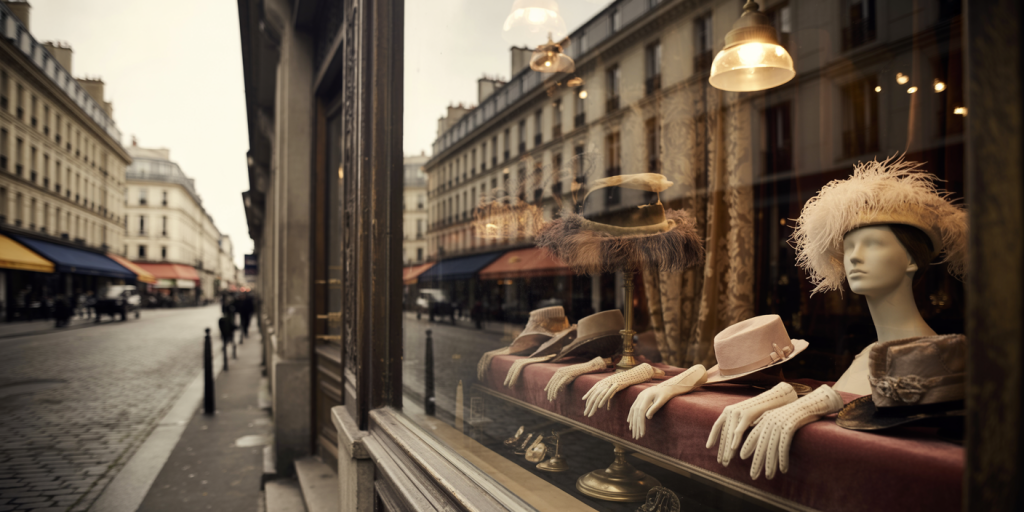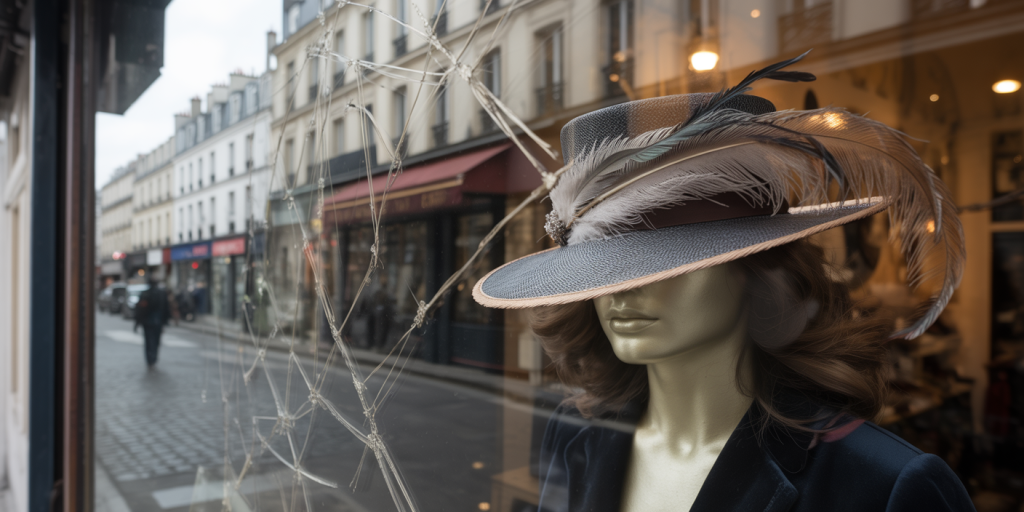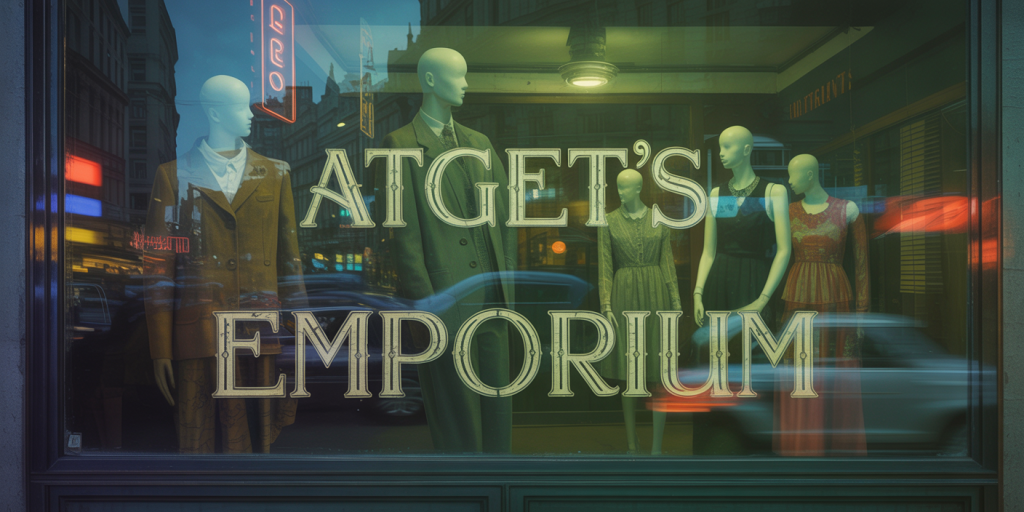The Strangeness of the Familiar in Eugène Atget’s Shop Windows
In the quiet corridors of dawn, before Paris stirs to life, Eugène Atget captured windows not as mere displays but as stage sets suspended between dreams and memories. His vitrines, drenched in the hush of early light, resemble still lives abandoned mid-thought—the mannequins linger like ghosts, the glass like a veil between realities. There is something haunting in their silence, something that hums in the space between recognition and doubt.
To gaze into one of Atget’s photographs is to enter a spell of suspended familiarity, where the ordinary morphs into the inexplicably strange. Here, fashion becomes specter, and objects seem to whisper secrets from the other side of the glass. These are not just photographs of windows; they are meditations on time, memory, and the disquieting magic of the seen yet unseen.

Table of Contents
- The Glass That Remembers
- Gowns That Breathe Without Bodies
- Mannequins in Purgatory
- The Theatre of Stillness
- Layers of Time in a Single Pane
- Light as a Ghost
- Textures that Shiver
- The Mirror as Oracle
- Echoes of Narcissus
- Reflections that Don’t Reflect
- Paris Behind the Curtain
- The Sleep of the Modern Gaze
- The Lure of the Inanimate
- Absence Framed
- Shadows That Speak
- The Silence of Silk
- A Window into the Subconscious
- Reverie in Sepia
- The Anatomical Melancholy of Composition
- When Familiarity Becomes Haunting
The Glass That Remembers
Atget’s glass is never clean nor merely transparent. It is mottled, streaked with the history of fingertips and fog. It remembers every eye that pressed against it, every hand that hovered with longing. Through it, we peer not just into a shop, but into the sediment of time. Layers accumulate—reflections of buildings, clouds, and passersby, ghosted over feathered hats and silk dresses.
The glass functions as a membrane. It divides and unites. We are inside and outside simultaneously. This paradox is the source of estrangement. We recognize the things behind the pane, yet they flicker, half-lost in superimposed reflections. Reality folds.
Gowns That Breathe Without Bodies
The dresses, frozen mid-flow, seem to breathe. Their creases suggest recent motion, as though a woman had just stepped away, or worse, disappeared. Their fabric curls as if remembering the curve of a hip or the shrug of a shoulder.
These garments become relics of absence. Their beauty is spectral—seductive yet chilling. They perform a femininity no longer tied to flesh, becoming abstractions of desire and memory. We are captivated, yet we mourn.
Mannequins in Purgatory
Mannequins in Atget’s vitrines are not lifeless; they are trapped. Their painted eyes never meet ours, but we feel watched. Some are headless, others faceless. They teeter on the edge of anthropomorphism.
There is a perverse sacredness in their stillness. Like saints in shrines, they await our prayers or our pity. And yet, their beauty is hollow—a parody of life. They disturb because they mimic us too well, and not well enough.
The Theatre of Stillness
Each shop window is a proscenium arch. The objects within are cast members paused before a cue. There is narrative potential, but no plot. Tension lives in the stillness.
Atget was a director of silence. He placed no actors, but allowed the city to perform itself. In this quiet theatre, the drama is internal. We are the protagonists, feeling the pull of forgotten stories awakened by a fur stole or an empty glove.
Layers of Time in a Single Pane
His vitrines collapse eras. A crumbling cornice reflects over a satin corset. A horse-drawn carriage ghosts past a gramophone. The past and present are laminated.
This temporal layering disturbs linear perception. We experience a simultaneity that is both poetic and uncanny. Time pools in the image, thick and motionless.
Light as a Ghost
Atget’s light is soft yet mournful. It does not illuminate—it caresses, mourns, lingers. The morning hush or the dusk sigh pervade his exposures.
This light makes objects appear sentient. A parasol glows like a halo. A shoe heel casts a shadow like a bruise. The light does not show us what is there; it shows us what is felt.
Textures that Shiver
There is tactility in his photographs. The glass seems cool to the touch. The velvet absorbs all light. The lace trembles with imagined breezes.
Atget invites us to reach out. Our fingers ache with desire to touch, to confirm the material. Yet we cannot. The photograph denies us contact. It amplifies longing.
The Mirror as Oracle
Mirrors abound in Atget’s vitrines. But they do not reflect the expected. Instead, they capture fragments, limbs, facades—as if memory itself had splintered.
These mirrors do not reveal; they obscure. They hint at secrets, at hidden selves. They function as portals, less about what is seen, more about what is almost seen.
Echoes of Narcissus
One cannot look into Atget’s glass without recalling Narcissus. The viewer becomes entranced not by their image, but by its distortion. The reflection is never pure.
This self-aware gaze collapses into itself. We see ourselves seeing. And like Narcissus, we are doomed to linger, caught in a loop of fascination and futility.

Reflections that Don’t Reflect
Sometimes, what should be mirrored isn’t. The angles are wrong. The reflections misbehave. A hat floats disembodied. A tree bisects a dress.
These disruptions unsettle. We trust glass to behave. When it does not, we doubt our senses. Atget turns physics into poetry.
Paris Behind the Curtain
Though these are shop windows, they are also cityscapes. Reflected architecture bleeds into interior arrangements. Paris becomes backdrop and co-conspirator.
The city haunts the scene like a shadow character. It peeks through, never fully present, but undeniably there. Atget’s Paris is not bustling; it’s paused.
The Sleep of the Modern Gaze
There is no spectacle here. No advertisement screams for attention. Instead, a lull. The viewer is invited to drift, to lose focus.
Atget anticipates surrealism, yet resists its flamboyance. His images lull the gaze into a trance, awakening deeper intuitions. The modern eye is seduced into slumber.
The Lure of the Inanimate
Atget’s objects seem more alive than people. A feathered fan has more charisma than a politician. A button shines with intention.
We are reminded of animism, the belief that objects have souls. In Atget’s world, this is no metaphor. It is visual truth.
Absence Framed
There are no customers. No salesmen. Just things. Things waiting. This absence howls. It makes space for the uncanny.
We are left to imagine the lives that intersected here. Every image is a funeral for the mundane. Atget frames what was almost lost.
Shadows That Speak
Shadows in his work are not emptinesses. They speak, they linger. A hat casts a shadow that resembles a face. A parasol’s shadow becomes a lover’s silhouette.
These are not coincidences. They are visual murmurs. The subconscious leaves traces, and Atget listens.
The Silence of Silk
Sound is absent, yet we hear. We imagine the rustle of fabric, the clink of glass. The silence in his images is not mute, but musical.
Silk whispers in folds. Gloves sigh. These imagined sounds reinforce the sensory spell. We are immersed not in noise, but in echo.
A Window into the Subconscious
These photographs are dreams we forgot we had. The window becomes eyelid. The scene becomes reverie.
Atget captures the surrealism of the real. He makes no manipulation, yet everything feels altered. This is Freud in silver gelatin.

Reverie in Sepia
Colorless, yet rich. Sepia is memory’s hue. It softens the real, turns it into recollection. These are not documents, but dreams preserved.
Atget does not mourn the lack of color. He exploits it. The tones breathe nostalgia. They burn slow, like incense.
The Anatomical Melancholy of Composition
His framing is meticulous, but never clinical. A glove is half-out-of-frame. A mirror cuts a body. Composition aches with intention.
This partiality evokes longing. We never get the full picture. It is the anatomy of sadness—beauty defined by what’s missing.
When Familiarity Becomes Haunting
Why do these familiar scenes disturb? Because they echo our own condition. We live behind glass, observed but untouchable.
Atget’s vitrines are mirrors of society. Their strangeness lies in their truth. They do not distort the world; they reveal its hidden eeriness.
FAQ
Who was Eugène Atget?
A French photographer (1857–1927) known for capturing old Paris before modernization. His work deeply influenced the Surrealists and the documentary style.
Why are his shop windows so significant?
They reflect themes of memory, absence, and the uncanny. Though mundane in subject, they evoke emotional and philosophical depth.
Did Atget consider himself an artist?
No. He saw himself as a documentarian. Yet, his sensibility turned documentation into poetry.
What camera did Atget use?
A large-format bellows camera with glass plates. This required long exposures, which added to the dreamlike stillness.
Was he recognized during his life?
Barely. His acclaim grew posthumously, especially after being discovered by Man Ray and Berenice Abbott.
Why do his photos feel so modern?
Because they explore perception, identity, and alienation—themes central to 20th and 21st-century thought.
What movements did he influence?
Surrealism, documentary photography, modernism.
How do his photos relate to Freud’s concept of “the uncanny”?
They present the familiar in unsettling ways. Everyday scenes become eerie, resonating with Freud’s definition of the uncanny as the “strangely familiar.”
Final Reflections: The Haunting Echo Behind the Glass
Atget did not stage, did not manipulate. He merely bore witness. Yet what he captured was not reality—it was the fracture in reality, the tremor beneath the mundane.
His vitrines are not windows to products, but to psyche. They reveal how we reflect and refract, how we are seen and unseen. In their silence, they shout. In their stillness, they weep.
In an age of relentless spectacle, Atget’s work reminds us of the quiet horror of the everyday. The mannequin, the glove, the feathered hat—these are our oracles. They whisper, and in listening, we remember the strangeness of being alive.
